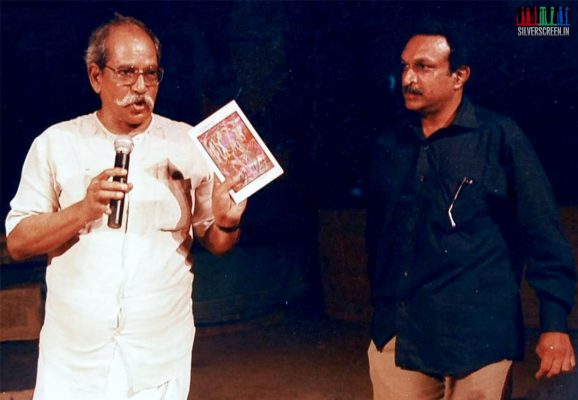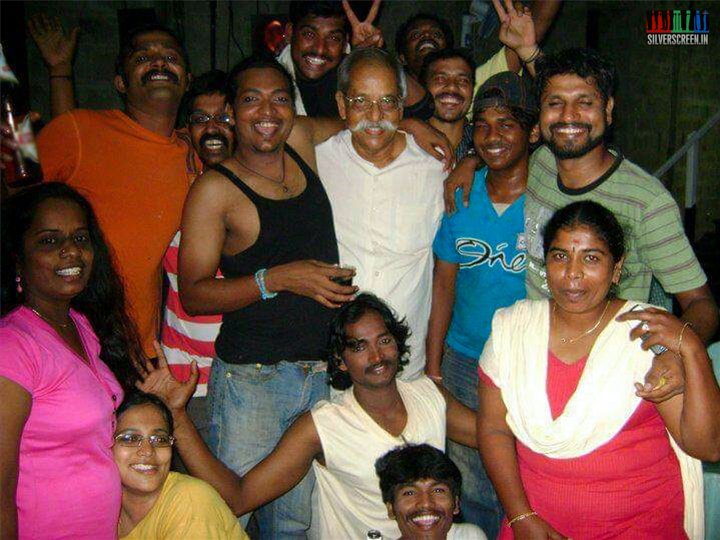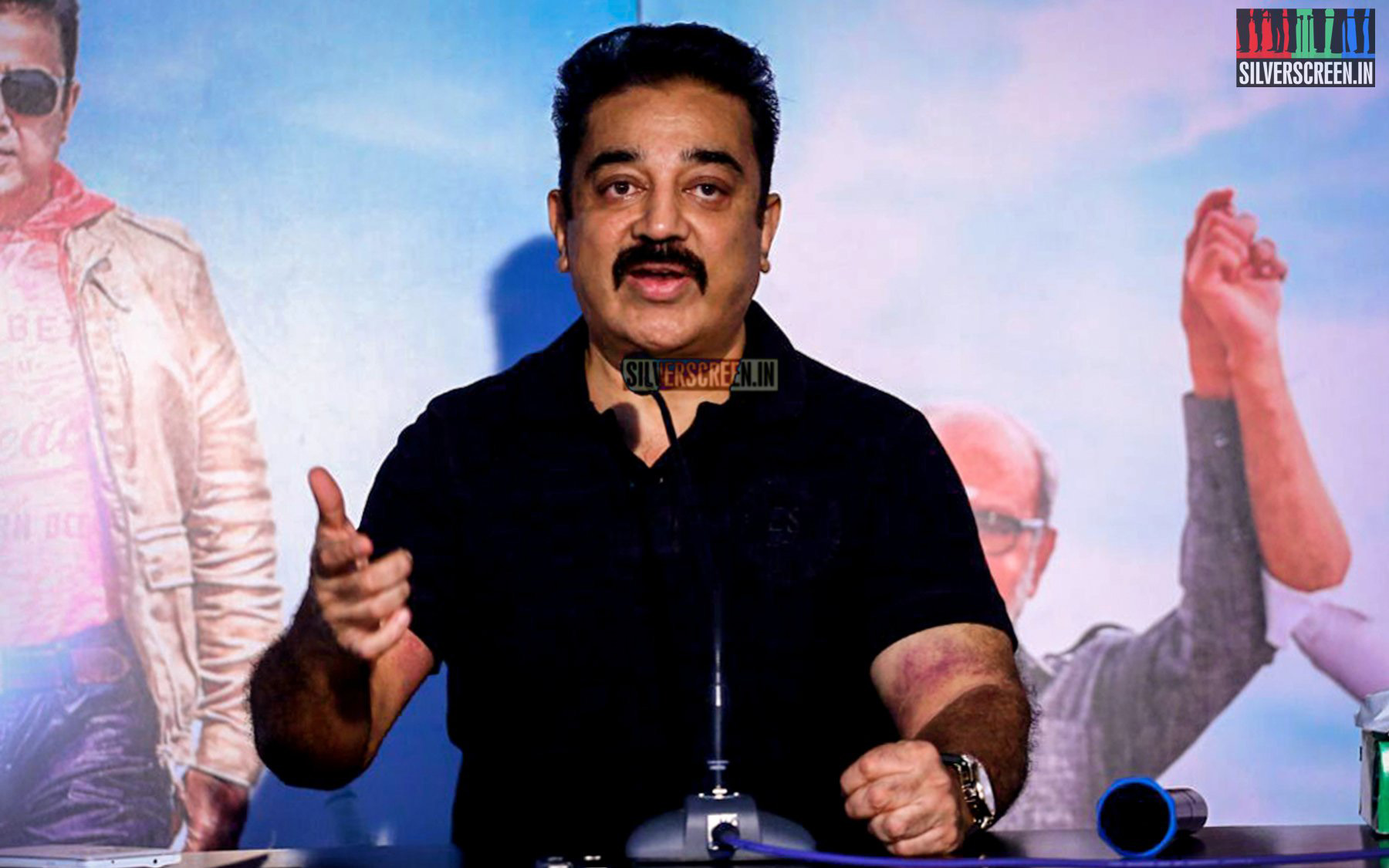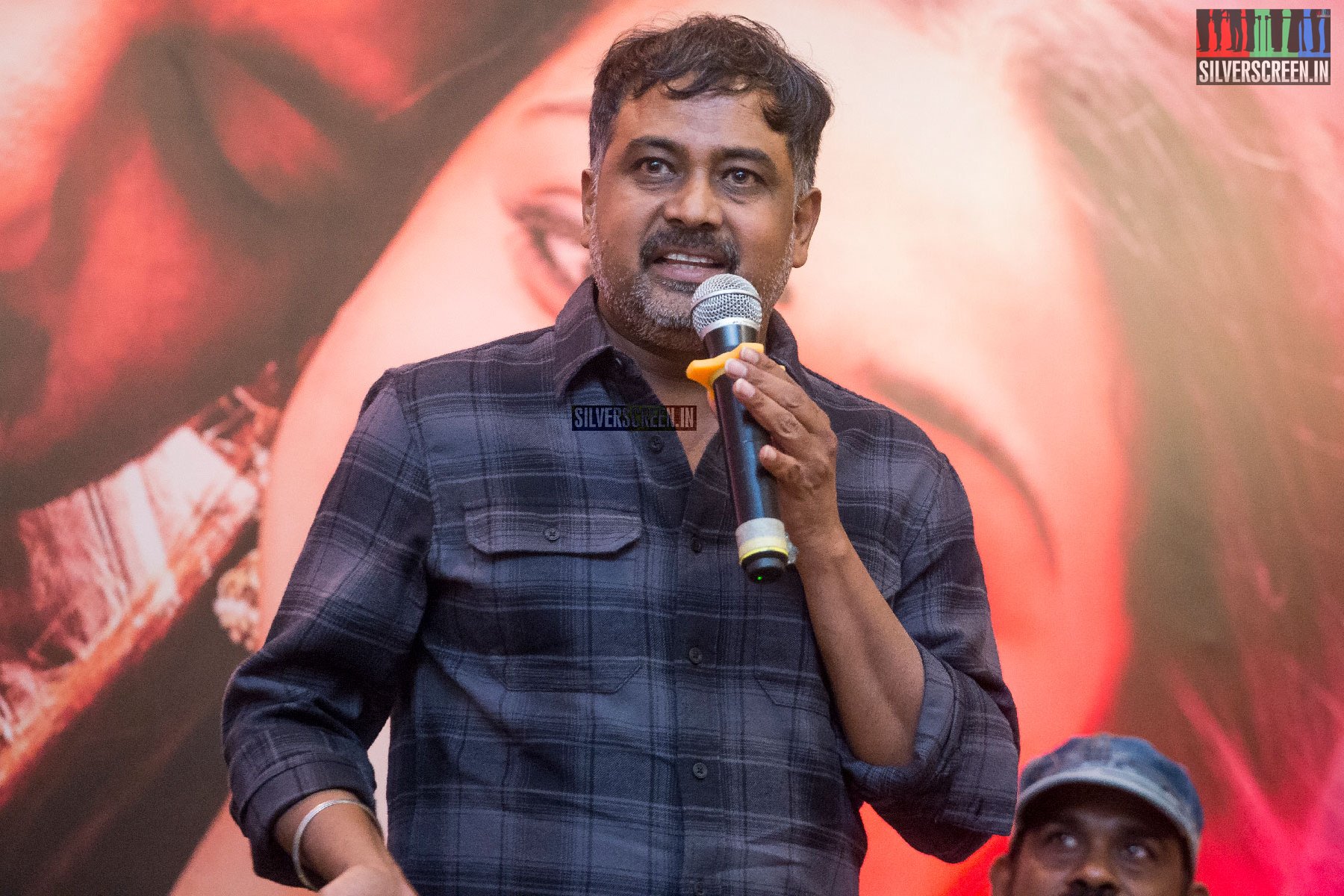This is a guest post by Vinodhini Vaidynathan, student of Na. Muthuswamy
How does one begin to write an obituary for one’s guru, mentor and artistic inspiration? Teacher to a thousand students of theatre, playwright par excellence in the league of absurdists such as Harold Pinter and Edward Albee but rooted in Tamil and Tamil Nadu’s folk imagery and motifs, founder of one of the very few avant-garde theatre groups in the country, a theatre and art facilitator who enabled a whole generation of Koothu and other folk artistes to bring their art to urban theatre spaces, a Zen person who lived a householder’s life, devoted to his wife of more than 60 years and yet remained untouched by the petty issues that plagued mediocre artistes?
Maybe a good place to start is at the funeral of Theru-k-Koothu master Kannappa Thambiran, one of the innumerable associates of N Muthuswamy sir, as we fondly called him. Apparently, a recital of Sivapuranam was underway during his final rites, and Sir is known to have instructed the actors of Koothu-p-Pattarai to observe the theatrical possibilities of that performance. Or, possibly, that day in 2010 when a diffident me went to him with a 17-page terribly verbose resignation letter, telling him of my need to explore the world outside of Koothu-p-Pattarai. He read the letter, and said: “Sabaash! Neenga nalla ezhuthareenga (Bravo! You write well).” Such was the man’s ability to connect all of life to theatre, and teach his students the same.
Oh, but if one were to ask what he taught, I’d speak about what he didn’t teach. There was not one known session of learning where Muthuswamy sir ever declared, “This, then, is acting.” Yet, Koothu-p-Pattarai has produced probably some of the best theatre and film actors of today. And, it is not even a training institute, as misunderstood by many.
I first met him when I had gone to watch the play Chandrahari at Sivagami Pethachi Auditorium in 2003 or 2004. He was an imposing figure, with his characteristic murukku meesai, booming voice and awe-inspiring personality. In later years, when I was in Koothu-p-Pattarai full-time, anyone who visited the space, be it professors of theatre or literature, theatre practitioners from any part of the world, assistant directors coming in to audition actors or the regular tea-boy, everyone was welcome to stop over, have tea, watch rehearsals, give feedback to actors and participate in discussions. There was no closed door or cloistered process, prevalent in theatre groups that operate from an anglicised or Western psyche. In fact, there was nothing closed-door about Sir, whose house in Iyyappa Nagar (Chennai) was as open to any of us (including stray cats and dogs) as his theatre space was and continues to be.
Actors in Koothu-p-Pattarai prepared differently for a role. Dance, yoga, meditation, hara point exercises, improvs, music practice, regular warm-ups, script readings and analysis of each scene, each character… a few of the things that would go into a portrayal. The results obviously showed.
Little wonder, such a learning lab was the home ground for extensive experimentation in theatre, right from Koothu-p-Pattarai’s humble beginnings in 1977, the first decade when the group operated from various places, including Sitrarangam in Theevu Thidal and rented spaces in Kottivakkam and Chinmaya Nagar, before it shifted to its own black box studio built in Sir’s house terrace. Many theatre makers from within the country, Brazil, Mexico, Spain, France, Israel and Germany, among others, have entered and exited these spaces. They would teach or direct and return multiple times, adding to the richness of their repertoire from having interacted with Sir and the group.
There were interesting workshops — Ruth Ziv Ayal from Israel worked with stones, her compatriot Gil Alon taught Zen-based creativity, and Mexican circus performer Ingrid trained us in hard core physical work and rope climbing. Sir sat in all these workshops, a detached observer in the style of J Krishnamoorthy (whose philosophy and ideas he spoke and quoted from, often).

With-Muthuswamy-sir
Sir approached his art as a full-time job, a lifetime’s work. He was at the theatre space literally every single day, at the same time actors started work in the morning. The actors would go through a set of exercises that would involve anything from Zen cleaning (cleaning the theatre space in complete mindfulness), Devarattam dance and Silambam or Thudumbu practice with a teacher to workshopping with the script of a play in progress. After a short tea break, when Sir would have a cup of coffee with just two sugar-free tablets (I’ve been privileged to fix many of these mugs for him, as have other actors, when the cook was not present), we would sit in a semi-circle around him, for our daily discussion. Some days, it would be restricted to the script; on others, it would touch upon writing and authors, J Krishnamoorthy and Gurdjieff, playwriting, dramaturgy, painting, experiences of actors who have been to shoots/workshops outside, short story readings, play readings, history of theatre, Zen, music, philosophy and science. Actors were supposed to be present for all sessions, but were free to pursue areas/streams of their choice. If an actor chose to sit out or not participate in a particular play, it was okay provided, he was occupied with something else meaningful. So, writer-actors such as Thambi Chozhan pursued writing while learning the craft of writing, musician-actors such as Prakash (who is sadly, no more) honing their musical talent, and lighting designers such as Bhaskaran who have made a profession out of stage lighting.
We rehearsed for plays from anywhere between three and five months. One of my fondest memories of Sir, which I have recounted often to my actors and people I work with, was when we spent a whole hour devising a particular scene from a play. After that, we sat around him expecting feedback. He pointed to Koothu-Pattarai’s dog USA (who is also no more; why he was called USA is a tale for another day) and said, “Athu evvalavu azhaga udambai valaikkudhu paarunga (See how beautifully he moves his body).” USA was definitely the better performer that day. As Kalairani, one of Koothu-p-Pattarai’s earliest and senior-most actors once said: “We used to wait to see a single smile on that man’s face, to know that we have done well, to have our work validated.”
Political-ideology wise, he was left of centre, but supported no political party. In 2008, I was witness to a Dravidian party enquiring if Koothu-p-Pattarai would put up some street plays for them. Sir refused, though indulging them might have won him recognition, political clout or a space for Koothu-p-Pattarai. His political critique was superbly and humorously woven into every satirical word of his writing, and his disgust at the inherent oppressive nature of State and establishment and his subversive take on society apparent in every scene of every play he wrote.
Whether it was the hapless Aravan in Padukalam, yearning for conjugal bliss on his wedding night before going to war and lamenting that he might die a virgin; the ubiquitous Kattiyakkaran who narrates and frequently time-travels in Sir’s plays; the Narkaalikkaarar of the eponymous play who moderates between the Goligundu goshti (Marbles gang) and the Seetukkattu Goshti (Card-playing gang); or even Ekalavya’s shishyas in Arjunan Thapasu who demand justice for their master who was unfairly treated in a previous era, Sir’s characters were always subverts who questioned or toppled the status quo, tore apart hitherto unchallenged conventions and exposed the world for the glaringly crazy place it is. And, he did it with such style, candour and absolute mastery of Tamizh.
In 2016, Karuna Prasad, one of KPP’s senior actors, published the entire collection of Sir’s plays, becoming one of the very few people who gave back to Koothu-p-Pattarai and Sir, as much as they received. But, Sir was a benevolent leader who expected nothing, and was grateful for anything offered without asking. He demanded nothing of his students, except at work, where he forcefully commanded excellence and a constant effort towards perfection.

IMG-20181103-WA0015
Growing up, I was a painful introvert. Koothu-p-Pattarai was staging Luigi Pirandello’s Six Characters In Search Of An Author, directed by Gil Alon, and I was there for at least five of the 10 or 15 days they played at Chinmaya Nagar, Virugambakkam. Noticing me, he would ask, “Innikki eppadi irunthathu? (What is your feedback today?)” Only I know how validated I felt that such a mighty stalwart was willing to seek the feedback of a nobody. Later, I would come to know that he would incorporate any relevant feedback in the next rehearsal. To him, rehearsals and the process were as important as the end product.
In a world where everything is judged according to its market value, Sir stood tall. For him, no one was a nobody. Every single person who crossed his path was examined for his or her unique skills, and these were acknowledged whole-heartedly and appreciated honestly and directly. These are qualities we seek to imbibe.
But beyond all this, the most important learning I received from Sir was his impartial outlook about life. Whenever personal tragedies threatened to engulf me, Sir’s dispassionate words, even something innocuous such as “azhaatheenga” (Don’t cry) or “intha situation-a paarunga” (Just observe the situation) had the power to make me ignore the trees and look at the woods. This is his legacy to me, I realised, as he lay lifeless in Koothu-p-Pattarai, and I sat observing the brilliant drama of death unfold around me. I am sure Sir was watching along with me, with his usual intense expression, a smile playing about his mouth, as he remarked, “Sabaash.”
Veli Rangarajan of Veli, a Tamil journal for theatre, art and literature, documented the activities of Koothu-p-Pattarai and every play it worked on. In an interview in the 90s, he asked Sir: “There seems to be a recurring complaint that your plays are not easily understood and are a bit obscure…” Sir believed it was not his duty to water down his thoughts or dumb down ideas – the audience had to scale up its understanding. So absolute was he in refusing to pander to populist notions of what theatre and writing should be, that his genius remained as much in the shadows as he did.
As his students danced one last dance for Sir, outside his home and our beloved pattarai, someone asked, “Sir avlo periya aala? (Was he that big a person?)” more in ignorance than awe. A Padma Shri awardee, a Sangeet Natak Akademi awardee, a doyen of Tamizh theatre who veritably shaped its course in the last 40 years, and yet, most people today do not know of him or his work. An understated, undervalued human being, playwright, writer and theatre personality, whose loss to Tamil society is nothing short of frighteningly huge, if only it has the sensibility to see it.
However, if one were to speak of this to Sir, or rant about how popular entertainment has engulfed almost every form of alternative artistic expression, he would repeat his favourite phrase: “Ellaathukkum idam irukku” (There is a place for everything). In that sense, he was an eternal optimist who hoped for a better world. It is each of his students’ duty to keep that beacon of hope burning bright and to carry his work, writing and philosophy into the future, so that generations of theatrepersons and artistic explorers can have a reference point, a moral artistic compass to chart their own courses by.
(Film and stage actor and theatre director Vinodhini Vaidynathan has been associated with Koothu-p-Pattarai for the past 12 years.)



